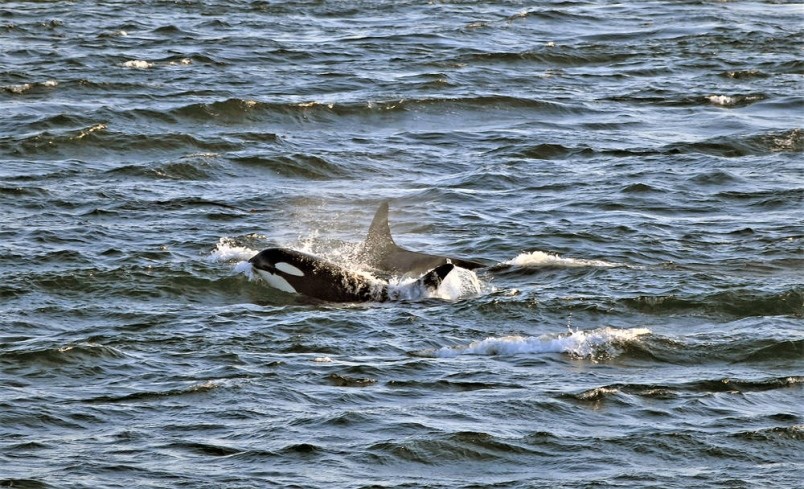The endangered southern resident killer whales are back in town.
Members of J-, K- and L-Pods were spotted mingling and breaching on the west side of the San Juan Islands on Tuesday night. It was a significant gathering, especially for J-Pod, which hasn’t been seen anywhere in the Salish Sea since April 10 — an “unprecedented” 108 days.
Southern residents were also spotted Tuesday near Sooke travelling eastbound on inland waters toward Victoria, according to Dustin De Gagne, supervisor of the Department of Fisheries and Oceans Whale Protection Unit.
The pod is being monitored by crews of Straitwatch, which reported the orcas were moving quickly into open water on the Strait of Juan de Fuca late Wednesday afternoon.
Rosie Poirier, program co‑ordinator for Straitwatch, has been monitoring the pod since Tuesday. “From what I can see, [their health] looks fine,” she said from the vessel Wednesday.
It wasn’t immediately clear if the Sooke group was a mix of pods or just J-Pod.
Deborah Giles, a research biologist for the University of Washinton's Center for Conservation Biology and research director for the non-profit Wild Ocra, watched the orcas’ “amazing” display from the shore on the San Juan Islands.
“There was a mix of different pods breaching and tail slapping and leisurely moving through the water … it was just like it used to be,” she said.
Included in the show was the youngest of the southern residents, L25, born in February and recently determined to be female, a good sign for the endangered group, which has just 74 remaining.
De Gagne said DFO scientists are studying the long absence and return of J-Pod, but the general theory is that the pod left the area around the San Juan Islands, Victoria and the southern Gulf Islands in search of more plentiful chinook salmon, their main food source and what sets the southern residents apart from transient Biggs orcas, which also eat seals.
“Their patterns have been atypical,” said De Gagne.
Although it’s difficult to say without confirmed sightings, De Gagne said it seems the southern resident pods may be doing a “clockwise trip around Â鶹´«Ã½Ó³»Island, now looking elsewhere for food.”
Another theory is that the death in 2016 of J-Pod’s venerable matriarch, J2 or Granny, at an estimated age of 106, caused the group’s travel patterns to change, said De Gagne.
The southern resident orcas are a highly structured social group, with members relying on matriarchal knowledge of food sources and help to raise their young.
Monika Wieland Shields, director of Orca Behavior Institute in Friday Harbor, Washington, said several decades ago, J-Pod was seen nearly daily in the Salish Sea, which is considered the orcas’ core summer habitat and where they would feed on chinook salmon that returned to the Fraser River.
“The fact that they’re not here is an indicator that that food is not here for them,” Wieland Shields said last week.
“We’re concerned about the change in the ecosystem and food availability for these endangered whales and making sure that they’re healthy and able to get enough to eat.”
Between 1976 and 2013, the pod was documented in the Salish Sea every month of every year, she said.
Since April 2013, there have been sporadic stints without any documented sightings, “but never a stretch this long.”
The other two pods, L and K, have not been documented in inland waters since late February, except for a brief visit by K-Pod to the San Juans on July 1. Those pods have typically spent more time on the outer coast, so their absence is not as unusual.
Giles said the orcas looked healthy and robust, adding K-Pod whales looked “much better” than their last visit July 1. She is concerned, however, that the pod gathering didn’t last and the orcas moved on quickly— a sign there was probably no food in the area.
With files from Roxanne Egan-Elliott




